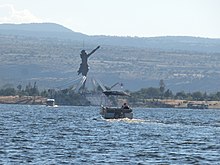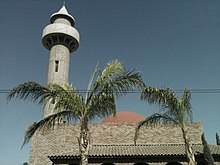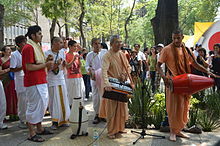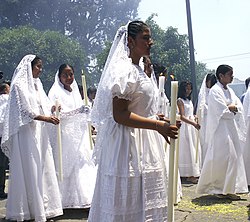Religion in Mexico
Religion in Mexico (2020 census)[1]
| Religion by country |
|---|
|
|

Mexico is a
Religion and the state

The Mexican
In a major reversal of the Mexican state's restrictions on religion, the constitution was amended in 1992 lifting almost all restrictions on the religions, including granting all religious groups legal status, conceding them limited property, and lifting restrictions on the number of priests in the country.[5] Until recently, priests did not have the right to vote, and even now they cannot be elected to public office.
Historical Trends
- Sources: Based on Pew Center Research (including historical percentages of Catholicism)[6] and the National Institution of Statistics and Geography (INEGI) both historical Census and specially 2010[7] and 2020 Census,[8] according to WorldDataValue and Latinobarómetro, Catholicism grew since 1995 or end-90s, in fact almost 30% of Mexicans are involved in religious denomination changes one, twice or more times, near 70% has been always Catholic affiliated (compared to 82% in 1960) and near 3% has been from other religion or none.
Graphs are unavailable due to technical issues. There is more info on Phabricator and on MediaWiki.org. |
Abrahamic religions
Christianity

Historically the Catholic Church in Mexico is the oldest established church, established in the early sixteenth century. At independence, the Catholic Church kept its status as the only permissible church in Mexico. In the mid-nineteenth century, Mexican liberals curtailed the exclusive standing of the church, and Protestant missionaries, mainly from the United States, legally evangelized in Mexico. Other Christian denominations have grown in Mexico, dating from the twentieth century. With the growth of immigration from the Middle East, Eastern Catholic churches were established.[citation needed] Evangelical Protestant churches have expanded their reach significantly from the late twentieth century.
Catholicism

Catholics are 77.8%[1] of the total population,[9] down from 82.7%[10] in 2000 and 96% in 1970.[11] The number of Mexican Catholics has fallen by 5% in the first decade of the 21st century and in the south-east Catholics make up less than two-thirds of the population.[11] In absolute terms, Mexico has 90,224,559 Catholics,[1] which is the world's second largest number of Catholics, surpassed only by Brazil.[12]
More than half of Mexicans Catholics are actually, nominal, some combine or
There are major festivities in Mexico celebrating the Christian holidays of Epiphany (6 January) (Día de los Reyes Magos), All Saints' day (1 November), All Souls' day or Day of the Dead (2 November)(Día de los fieles difuntos), and the feast of Our Lady of Guadalupe (12 December). These are not public holidays in Mexico. Christmas is celebrated as a religious and public holiday.
Eastern Catholicism in Mexico
There are also Eastern Catholic Churches that exist alongside the Roman/Latin Catholic Church in Mexico, all of which are in communion with the bishop of Rome or the pope. The Vatican II document, "Orientalium Ecclesiarum" (Of Eastern Churches), proclaimed that "Eastern Catholic communities are true Churches and not just rites within the Catholic Church."[13] Carlos Slim, for example, is a Maronite Catholic and a member of the Maronite Church.
- the Maronite Catholic Eparchy of Our Lady of the Martyrs of Lebanon in Mexico[14]
- the Melkite Greek Catholic Eparchy of Nuestra Señora del Paraíso in Mexico City[14]
- the Armenian Catholic Apostolic Exarchate of Latin America and Mexico [citation needed]
Protestantism
About 11% of the population (6,160,000 people over the age of 5, according to the 2000 census, including Jehovah's Witnesses and Mormons who are usually considered to be non-Protestant and part of Restorationism or individual Christian branches) are Protestant,[10] of whom Pentecostals and Charismatics (called Neo-Pentecostals in the census), are the largest group. The Anglican Communion is represented by the Anglican Church of Mexico.
Protestantism is strongest where the Catholic Church and the Mexican state have little presence,[11] and accounts for over 10% of the population in the four states that border heavily-Protestant Guatemala: Campeche, Chiapas, Quintana Roo, and Tabasco. It is also sizable in the Mexican states that border the U.S. State of Texas. Protestantism had been on the rise as it offers a less legalistic and hierarchical version of Christianity.[15] But in some recent surveys like Latinobarometro, Protestantism in the whole country has dropped from nearly 10% to less than 5%, in counterpart, between 2010 and 2020, the Census recorder an increase from 8% to 11%, ARDA estimated 10.7% in 2015.
Eastern Orthodoxy
There are some Mexicans practicing
Seventh-day Adventist
There are also a number of Seventh-day Adventists (488,946 people).[10]
Jehovah's Witnesses
The 2000 national census counted more than one million Jehovah's Witnesses.[10] According to the Jehovah's Witnesses official figures for 2014 there were over 800,000 members involved in preaching.[18]
The Church of Jesus Christ of Latter-day Saints

The first
The 2010 Census reported 314,932 Mormons.[19] As of 2015, The Church of Jesus Christ of Latter-day Saints (LDS Church) claims 1,368,475 members, 231 stakes, 1,998 congregations, and 12 temples in Mexico.[20]
La Luz del Mundo
Islam

The Pew Research Center estimated that there were 111,000 Muslims in Mexico in 2010.
Judaism
The presence of
Bahá'í Faith
The
With continued growth the
Indian Religions
This section needs additional citations for verification. (July 2019) |
Buddhism
Approximately 108,701 Buddhists are counted in Mexico.[
There are also two institutions from Theravada Buddhism tradition, the Theravada Buddhist Monastery and the Vipassana House of Meditation. There are at least 30 Buddhist groups in Mexico.[2]
Hinduism

There are about 800 Indian families in Mexico, constituting about 900
Sikhism
There are around 8,000 Sikhs in Mexico. Most of them are of Punjabi origin.
Nonreligious
It's important to specify that irreligion and
Majority of population is Theistic but religious particing is very much lower as the expected on a very christian-religious continent, recent surveys have shown that around 3% of Catholics attend church daily and 44% attend church at least once a week.[36]
Census information
| Religion | Numbers | Percent |
|---|---|---|
| Catholic | 92,924,489 | 82.72 |
| Anabaptist/Mennonites[table 1] | 10,753 | 0.01 |
| Baptist[table 1] | 252,874 | 0.23 |
| Church of the Nazarene[table 1] | 40,225 | 0.04 |
| Methodist[table 1] | 25,370 | 0.02 |
| Presbyterian[table 1] | 437,690 | 0.39 |
| Other historic Protestant[table 1] | 53.832 | 0.05 |
| Pentecostal[table 2] | 1,782,021 | 1.59 |
| Other Christian Evangelical[table 2] | 5,783,442 | 5.15 |
| Seventh day Adventist[table 3] | 661,878 | 0.59 |
| Mormons[table 3] | 314,932 | 0.28 |
| Jehovah's Witnesses[table 3] | 1,561,086 | 1.39 |
| Eastern religions | 18,185 | 0.02 |
| Judaism | 67,476 | 0.06 |
| Islam | 3,760 | < 0.01 |
| Native religions | 27,839 | 0.02 |
| Spiritualism | 35,995 | 0.03 |
| Other religions | 19,636 | 0.02 |
| No religion | 5,262,546 | 4.68 |
| Not specified | 3,052,509 | 2.72 |
Notes
| ||

State
|
Catholic
|
Protestant and Evangelical | Other Christian | Jewish | Other | None | Not specified |
|---|---|---|---|---|---|---|---|
| Aguascalientes | 95.6% | 1.9% | 0.7% | <0.1% | 0.1% | 0.8% | 0.7% |
| Baja California | 81.4% | 7.9% | 2.7% | <0.1% | 0.2% | 6.2% | 1.6% |
| Baja California Sur | 89.0% | 4.0% | 1.9% | <0.1% | 0.2% | 3.6% | 0.1% |
| Campeche | 71.3% | 13.2% | 4.7% | <0.1% | 1.7% | 9.9% | 0.8% |
| Chiapas | 63.8% | 13.9% | 9.0% | <0.1% | <0.1% | 13.1% | 1.2% |
| Chihuahua | 84.6% | 7.1% | 2.0% | <0.1% | 0.1% | 5.1% | 1.1% |
| Coahuila | 86.4% | 6.8% | 1.8% | <0.1% | 0.1% | 3.8% | 1.1% |
| Colima | 93.0% | 2.9% | 1.4% | <0.1% | 0.1% | 1.8% | 0.8% |
| Durango | 90.4% | 3.9% | 1.8% | <0.1% | <0.1% | 2.9% | 0.9% |
| Mexico City | 90.5% | 3.6% | 1.3% | 0.2% | 0.8% | 2.9% | 0.7% |
| Guanajuato | 96.4% | 1.3% | 0.7% | <0.1% | 0.1% | 0.7% | 0.7% |
| Guerrero | 89.2% | 4.4% | 2.0% | <0.1% | 0.4% | 3.1% | 0.9% |
| Hidalgo | 90.1% | 5.2% | 1.3% | <0.1% | 0.4% | 1.6% | 0.7% |
| Jalisco | 95.4% | 2.0% | 0.9% | <0.1% | <0.1% | 0.9% | 0.7% |
| Mexico | 91.2% | 3.8% | 1.6% | 0.1% | 0.7% | 1.8% | 0.8% |
| Michoacán | 94.8% | 1.9% | 1.1% | <0.1% | 0.2% | 1.3% | 0.8% |
| Morelos | 83.6% | 7.3% | 3.1% | 0.1% | 0.5% | 4.3% | 1.0% |
| Nayarit | 91.8% | 3.0% | 1.3% | <0.1% | 0.2% | 2.9% | 0.7% |
| Nuevo León | 87.9% | 6.2% | 2.0% | <0.1% | 0.1% | 2.8% | 0.9% |
| Oaxaca | 84.8% | 7.8% | 2.3% | <0.1% | 0.2% | 4.0% | 0.9% |
| Puebla | 91.6% | 4.3% | 1.4% | <0.1% | 0.4% | 1.4% | 0.8% |
| Querétaro | 95.3% | 1.9% | 0.9% | <0.1% | 0.2% | 0.9% | 0.8% |
| Quintana Roo | 73.2% | 11.2% | 4.6% | <0.1% | 0.2% | 9.6% | 1.1% |
| San Luis Potosí | 92.0% | 4.6% | 1.0% | <0.1% | 0.2% | 1.5% | 0.7% |
| Sinaloa | 86.8% | 2.9% | 2.0% | <0.1% | <0.1% | 7.1% | 1.0% |
| Sonora | 87.9% | 4.8% | 1.8% | <0.1% | <0.1% | 4.4% | 1.1% |
| Tabasco | 70.4% | 13.6% | 5.0% | <0.1% | <0.1% | 10.0% | 0.8% |
| Tamaulipas | 82.9% | 8.7% | 2.4% | <0.1% | 0.2% | 4.9% | 1.0% |
| Tlaxcala | 93.4% | 2.9% | 1.4% | <0.1% | 0.4% | 1.0% | 0.9% |
| Veracruz | 82.9% | 6.9% | 3.3% | <0.1% | 0.2% | 5.9% | 0.8% |
| Yucatán | 84.3% | 8.4% | 3.0% | <0.1% | 0.1% | 3.5% | 0.8% |
| Zacatecas | 95.1% | 1.9% | 1.0% | <0.1% | <0.1% | 1.1% | 0.8% |
| Mexico total | 87.99% | 5.20% | 2.07% | 0.05% | 0.31% | 3.52% | 0.86% |
Freedom of religion
The Constitution of Mexico and other laws establish and protect the freedom of religion in Mexico;[37] religious instruction is prohibited in public schools, but religious groups are allowed to maintain private schools.
Religious groups may not own or administer broadcast radio or television stations and government permission is required for commercial broadcast radio or television to transmit religious programming.[37]
In 2023, the country was scored 4 out of 4 for religious freedom.[38]
References
- ^ a b c d "Censo de Población y Vivienda 2020 – Cuestionario básico". INEGI. Retrieved May 18, 2022.
- ISBN 1-57607-004-2page 571
- ^ Yolotl González Torres. The Revival of Mexican Religions: The Impact of Nativism. Numen. Vol. 43, No. 1 (Jan. 1996), pp. 1–31
- ^ Zotero Citlalcoatl. AMOXTLI YAOXOCHIMEH.
- ^ "Mexico". International Religious Report. U.S. Department of State. 2003. Retrieved 4 October 2007.
- ^ "Religion in Latin America, Widespread Change in a Historically Catholic Region". Pew Research Center. Retrieved March 4, 2015.
- ^ "Censo de Población y Vivienda 2010 – Cuestionario básico". INEGI. Retrieved March 4, 2011.
- ^ 2020 Mexican Census (INEGI)
- ^ "Church attendance". World Values Survey. 1997.
- ^ INEGI. 2000. Archived from the original(PDF) on 25 September 2007. Retrieved 4 October 2007.
- ^ a b c “Religion in Mexico: Where angels fear to tread: Evangelicals are swooping on long-ignored regions”, The Economist, dated 24 March 2012.
- ^ "The Largest Catholic Communities". Adherents.com. Archived from the original on August 18, 2000. Retrieved 10 November 2007.
{{cite web}}: CS1 maint: unfit URL (link) - ^ Richard Mc Brien, The Church: The Evolution of Catholicism (New York: Harper One, 2008) 281, 450.
- ^ a b "RITOS" [Rites]. Misas.org (in Spanish). Retrieved July 21, 2019.
- ^ "Religion in Mexico: Staying alive, Mexicans are increasingly turning away from the Catholic church". The Economist. Mexico City. 25 July 2002. Retrieved 7 November 2012.
- ^ Orthodox History website, Cinco de Mayo and the lost Orthodox Missions of Mexico, article by Nicholas Chapman dated May 4, 2018
- ^ Iglesia Ortodoxa Antioquena
- ^ 2015 Yearbook of Jehovah's Witnesses. Watch Tower Society. p. 182.
- ^ a b Panorama de las religiones en México 2010 (PDF). Instituto Nacional de Estadística y Geografía. p. 3. Archived from the original (PDF) on 21 October 2015. Retrieved 28 December 2014.
- the Church of Jesus Christ of Latter-day Saints membership statistics#North America
- ^ "Table: Muslim Population by Country". Pew Research Center. 27 January 2011. Retrieved 19 March 2017.
- ^ "Mexican Catholics find God in Islam". Public Radio International. 13 February 2014. Retrieved 19 March 2017.
- ^ "Indígenas musulmanes abren plática sobre el Islam en San Cristóbal". quadratin.com. 22 August 2015. Retrieved 19 March 2017.
- ^ Fitra Ismu Kusumo. Islam en el Mexico Contemporaneo. Retrieved 8 November 2014.
- ^ a b Lamb, Artemus (November 1995). The Beginnings of the Bahá'í Faith in Latin America:Some Remembrances, English Revised and Amplified Edition. West Linn, OR: M L VanOrman Enterprises.
- ^ Abbas, `Abdu'l-Bahá (April 1919). Tablets, Instructions and Words of Explanation. Mirza Ahmad Sohrab, trans. and comments.
- ^ a b "Comunidad Bahá'í de México". National Spiritual Assembly of the Bahá'ís of Mexico. 2012. Retrieved 25 February 2012.
- ^ Hassall, Graham; Universal House of Justice. "National Spiritual Assemblies statistics 1923–1999". Assorted Resource Tools. Bahá'í Library Online. Retrieved 10 May 2009.
- ^ "Most Baha'i Nations (2005)". QuickLists > Compare Nations > Religions >. The Association of Religion Data Archives. 2005. Retrieved 4 July 2009.
- ^ Jodorowsky, Alejandro. The Spiritual Journey of Alejandro Jodorowsky The Creator of El Topo, Rochester, Vermont: (Park Street Press, 2005)
- ^ Thlate 1960s.City Paper – Jodorowsky
- ^ "Religión". INEGI.org (in Spanish). 2010. Retrieved July 21, 2019.
- ^ "Most Atheist Countries 2022". World Population Review. Retrieved April 4, 2022.
- ^ Aciprensa
- ^ Catholic News Agency
- ^ Roderic Ai Camp, Roderic A Camp, Crossing Swords: Politics and Religion in Mexico, Oxford University Press 1997.
- ^ a b International Religious Freedom Report 2022: Mexico (Report). U.S. Department of State. December 30, 2022.
- ^ Freedom House website, Mexico, retrieved 2024-01-04
Further reading
- Dow, James W. "The Expansion of Protestantism in Mexico: An Anthropological View." Anthropological Quarterly, Vol. 78, No. 4 (Autumn, 2005), pp. 827–851
